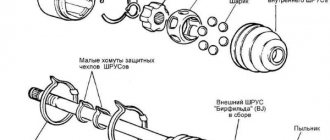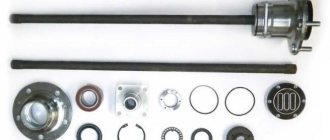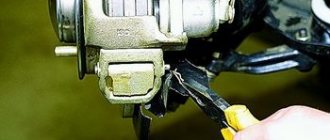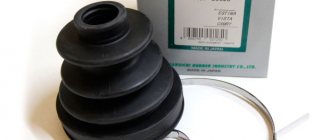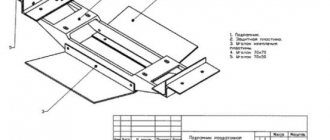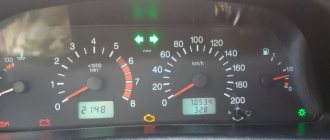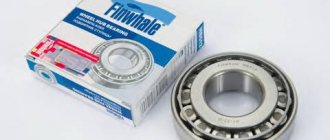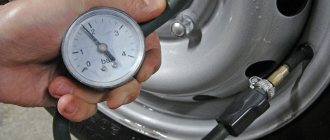Let's put everything back together.
Now you can install the joint on the shaft.
When you feel the splines, you should lower it until it comes into contact with the retaining ring located on the outside. Hit the CV joint with a hammer and force it into place. It is advisable to carry out this operation by installing a soft metal spacer on the part so as not to damage the hinge during an impact. Check the fixation of the part for reliability, do this in both directions.
Reinstall the anthers, followed by the clamps. Calculate the dimensions when installing so that when the car moves forward, the grass does not cling to the clamps. Don't be afraid to put in some serious effort when performing these operations, as this is where you really need to use force.
The work is almost complete, all that remains for you is to install the finished spare part on your Niva and enjoy its work.
Structure
When is it necessary to replace the outer CV joint on a VAZ 2109
Lada Granta hatchback Logbook Failed replacement of the CV joint boot
Important! If you decide to replace the CV joint yourself completely or change its individual parts, you need to understand its design, and only after that dismantle and subsequent replacement
Replacing a CV joint is an expensive procedure, which in a service center will significantly affect the thickness of the car owner’s wallet. The part is made of heavy-duty materials that are resistant to mechanical stress and aggressive environments. Accordingly, these materials, like the part itself, are quite expensive. It is designed for long-term operation, but not always road conditions and the driving style of the drivers themselves allow all parts of the chassis to be used for many years without the slightest breakdown.
And the cost of replacing a CV joint will be approximately half the cost of the mechanism. That is why many try to replace it themselves in order to save some money on repairs. But not everyone is born an auto mechanic, so the average person must first find out what parts the mechanism consists of. Here is their list:
- separator;
- balloons;
- fist;
- frame;
- outer and inner anthers.
The anthers perform two functions at once: they protect the hinge from dust and dirt. After all, in essence, a CV joint is an external part that is located on the bottom of the car. This means that all small particles when driving fall on the hinges in the same way as on the rest of the chassis.
On each wheel drive there are two mechanisms, which have almost the same structure, only slightly different in shape and size. As a rule, left and right CV joints are interchangeable on most car models. If you are in doubt, it is better to go to a car service center and ask if it is possible to buy left-handed hinges for right-hand drive on such and such a VAZ model for installation on right-hand drive, or vice versa.
Sometimes the entire mechanism requires repair, but more often it is the outer one that is worn out, while the inner one, as a rule, is almost eternal. But sometimes it may require replacement.
The design of the mechanism is not that complicated. The separator rotates the balls, which are located in the grooves of the fist and the outer housing. All this is covered by anthers that protect the parts from dirt and dust, as well as from leakage of lubricant. When replacing, the most difficult thing is to dismantle the mechanism itself so that you can install a new one entirely or change its individual parts.
replacing the CV joint boot on a Niva Chevrolet
The shaft was removed from a Niva Chevrolet car. Repair or replacement with a new one is carried out, and then assembly is carried out in the reverse order of removal. You can not hold the shaft, but fix it with a strong rope to the bottom of the car, or use the help of a friend. How to properly install the boot on the CV joint? This question is very popular on forums, but unfortunately few people pay attention to such user sites. If the balancing of the Chevrolet Niva cardan boot does not eliminate the problem of product malfunction, then the shaft assembly with all elements is replaced.
Balancing the cardan is done either by visiting a service station, where specialists will perform all the related work, or independently; a Chevrolet Niva cardan boot will save money.
Replacing the CV Joint on the Cardan Niva Chevrolet Video
But that is another story. Removing and replacing the driveshaft Removing and then replacing the driveshaft on Chevrolet Niva versions up to a year is carried out in the following order: The vehicle is installed on the overpass.
At the gearbox, the lever is placed in neutral and the parking brake is in position. Shoes are installed under the wheels for safety. Before removal, it is necessary to make notches on the ends of the flanges, drive axle and transfer case at the joints.
This will help return the shaft to its original position without the need for balancing.
Replacing rear universal joint CV joint boots - Chevrolet Niva Auster logbook of the year on IaaRus
The nut of the cardan bracket is unscrewed, while supporting the bolt so that it does not rotate. All fastening nuts are unscrewed in the same way. There are four of them on one side.
The nuts have a Teflon coating to protect them from self-rotation. After removal, even if the shaft is not replaced, it is recommended to replace the nuts with new ones.
Three fastening bolts are removed from one side, and the fourth one is left on the boot of the Chevrolet Niva cardan to fix the product in its original position. We carry out the operations of unscrewing the nuts on the other side of the fastening. The order of unscrewing does not matter. The last bolt is removed from one side and the cardan is removed, while its parts are reduced to the slot. The product has been removed, it is now being repaired, and if this is not possible, it is being replaced with a new one.
The installation procedure is the reverse of removal. First of all, the car is placed in neutral and the parking brake is in position.
It also keeps the lubricant from leaking out. Checking the serviceability of the Chevrolet Niva cardan boot The performance check is carried out with the PP box in neutral gear. The car is driven onto an overpass or inspection hole and shoes are placed under the wheels so that the car can move, but does not roll off the overpass.
Let's start testing. The check is carried out for both types of structures: All joints are inspected to see if there are any loose bolts, and what condition the boot is in. CV joint in the field km. Replacing the boot. Incorrect angle... Next, grab the shaft with both hands from the side where the boot of the Chevrolet Niva cardan joint is made, and swing with sharp movements. If there is a slight backlash, then the design is faulty.
There shouldn't be any play. With sharp movements it is necessary to rotate the shaft around its axis of rotation, while holding the joint fork-flange with one hand.
There should be no circumferential gaps. When the design of the device, so to speak, loses the balancing of the plates, or all parts of the product are replaced, then upon completion it is imperative to re-balance the driveshaft.
Let's start work.
Replacing the outer CV joint: how to do it?
Before starting work, be sure to install the Niva on the handbrake and insert wheel chocks under the rear wheels.
1. Loosen the wheel nuts, place the car on a jack and remove the wheel.
2. Place a secure support under the lower arm. Lower the jack and the lever will compress.
3. Remove the three bolts securing the lower ball joint and unscrew the nuts.
4. Knock the chrome hub cap through a wooden block and unscrew the nut. Make sure that the hub does not rotate; to do this, you can install some kind of stop under the wheel stud. A hammer is ideal.
5. Remove the cone washer.
6. Grasp the bottom of the brake disc and pull it towards you, then move it to the side. At the same time, the grenade axis should be removed.
The Niva CV joint has been released. You need to place it on the bottom cup in any place convenient for you.
Replacement of the front left outer and inner CV joint at the Niva
Help the project. Replacement
near the field of the front left
CV joint
, outer and
inner
.
Replacing the inner right and left CV joints Niva 2121 part-1
Video on the topic Do It Yourself CV16013 Grenade ( CV joint
) Niva internal
Fenox right 2121
21212215057 Grenade (
CV joint
) Niva.
Next, your task is to turn the CV joint and find a comfortable position in order to grab the clamp tabs with pliers. Having grabbed the clamp, you should squeeze it well, bend the hook and dismantle it. Leave marks on the car shaft, as well as on the grenade body. This is done so that later, when you put the part back in place, you assemble everything exactly as it was before the repair. When the boot is released, move it away from the grenade.
Now you need to get the wire type retaining ring on the CV joint housing. You can feel it with your finger and, using a screwdriver, pry it off at the break in the ring and remove it.
Grasp the shaft firmly and pull the CV joint of your Niva out of the body.
If you decide not to change the lubricant, you can put the spare part in a plastic bag and wrap it well to avoid dirt and loss of balls, which are attached only by good lubrication.
CV joint device VAZ 2121
All about changing the oil in a Niva Chevrolet engine
Both hinges include fundamentally the same elements, differing only in size and cost.
- cup-shaped housing with driven shaft;
- “fist” in the shape of a sphere with a drive shaft, forming a CV joint cage;
- steel balls located in special grooves of the holder and made of special types of metal.
When it is necessary to make a turn, the angles of both shafts change, the balls move along the grooves and transmit physical force to the wheels of the front axle. Usually a “Rtseppa” (“six-ball”) hinge is used. It cannot transmit torque from the gearbox on its own: for this, a shaft is used - a hollow steel pipe connecting the outer CV joint with the inner one. The latter operates continuously at a rotation angle of 10 degrees. The external unit operates in the same way, provided the movement is smooth. But as soon as the wheels turn, the angle at the outer joint increases to sixty degrees.
If the car moves on an uneven road, the distance from the outer unit to the inner one changes, so the shaft is mounted in such a way that it can either move in or out.
Chevrolet Niva 4x4 Chevrolet Niva 2012 Replacing the driveshaft CV joint
The cover on the back of the CV joint, which everyone was so worried about that it would get crushed on the shank nut, can be removed quite simply: You just need to sharply pull the CV joint itself down so that it is pushed out by the axle. During assembly, I decided to seal it with sealant.
Next, remove the CV joint itself from the axle. We take either a thick piece of wood or a metal flat attachment, place it on that same incomprehensible washer and knock it down in the same way as a regular outer CV joint on a drive. If you are careful and do not try to disassemble the CV joint system, you can get by with little damage.
I decided to find out what that incomprehensible washer is for. With sharp movements it is necessary to rotate the shaft around its axis of rotation, while holding the hinge fork-flange with one hand. There should be no circumferential gaps. When does a device need to be replaced?
When the design of the device, so to speak, loses the balancing of the plates, or all parts of the product are replaced, then upon completion it is imperative to re-balance the driveshaft. If, after balancing, the problems with the product malfunction are not eliminated, then the shaft assembly with all elements is replaced. Balancing the cardan is done either by visiting a service station, where specialists will perform all the related work, or independently, which will save money.
But that is another story.
Chevrolet Niva 4x4 Chevrolet Niva 2012 Replacing the driveshaft CV joint
Removing and replacing the driveshaft Removing and then replacing the driveshaft on Chevrolet Niva versions up to a year is carried out in the following order: The vehicle is installed on the overpass. At the gearbox, the lever is placed in the neutral position, and the parking brake is in the down position. Shoes are installed under the wheels for safety.
Before removal, it is necessary to make notches on the ends of the flanges, drive axle and transfer case at the joints. This will help return the shaft to its original position without the need for balancing.
The nut of the cardan bracket is unscrewed, while supporting the bolt so that it does not rotate. All fastening nuts are unscrewed in the same way. There are four of them on one side. The nuts are Teflon coated to prevent self-turning.
After removal, even if the shaft is not replaced, it is recommended to replace the nuts with new ones. Three fastening bolts are removed from one side, and the fourth is left to fix the product in its original position.
We carry out the operations of unscrewing the nuts on the other side of the fastening. The order of unscrewing does not matter. The last bolt is removed from one side and the cardan is removed, while its parts are reduced to the slot. The product has been removed, it is now being repaired, and if this is not possible, it is being replaced with a new one.
Device and features
The cardan transmission is a hollow steel tube. The metal thickness of the tube is from 1 to 2 mm. The following are welded to this tube on both sides:
- Splined tip;
- Hinge fork.
The fork of the second hinge is brought to the splined tip and put on it. This ensures a splined connection. This connection must be sealed with an oil seal, which is installed on the sliding fork.
So, torque on a Chevrolet Niva car is transmitted through cardans (front and rear), but we are only interested in the rear. On the Chevrolet Niva, the design of both the front and rear universal joints is almost the same, the only difference is the length of the device.
On restyled models, the design of the driveshaft has an improved appearance, and on models since 2010, the Chevrolet Niva is equipped with a drive shaft with joints of equal angular ends. The components of the rear cardan of Chevrolet Niva models before 2010 and the CV joint shaft of models from 2010 are shown in the photo below.
Picture "A" shows a steel base called the shaft (2). There are crosses at both ends, connected on one side by a shaft flange (1) and a sliding fork flange (4). There is also a sliding fork (3). On restyled models, the cardan design has already acquired a distinctive appearance from earlier modifications of the Chevy Niva, and is a shaft with constant-velocity joints (B). The image shows that the shaft consists of a tube (7), the CV joint itself (5) on both sides and, of course, boots. The boot is designed to protect the connection from getting inside not only dust, but also water and dirt. It also keeps the lubricant from leaking out.
Checking the serviceability of the cardan transmission
The performance check is carried out with the PP box in neutral gear. The car is driven onto an overpass or inspection hole and shoes are placed under the wheels so that the car can move, but does not roll off the overpass. Let's start testing. The check is carried out for both types of structures:
- External inspection. All joints are inspected to see if the bolts are loose, and what condition the boot is in.
- Next, the shaft is grasped with both hands on the side where the connections are checked, and rocking is carried out with sharp movements. If there is a slight backlash, then the design is faulty. There should be no backlash.
- With sharp movements it is necessary to rotate the shaft around its axis of rotation, while holding the hinge fork-flange with one hand. There should be no circumferential gaps.
When does a device need to be replaced?
When the design of the device, so to speak, loses the balancing of the plates, or all parts of the product are replaced, then upon completion it is imperative to re-balance the driveshaft. If, after balancing, the problems with the product malfunction are not eliminated, then the shaft assembly with all elements is replaced. If the shaft is not balanced, this will gradually lead to an increase in the amount of vibrations, especially at a speed of 60-80 km/h.
Balancing the cardan is done either by visiting a service station, where specialists will perform all the related work, or independently, which will save money. But that is another story.
Removing and replacing the driveshaft
Removal and then replacement of the cardan on Chevrolet Niva versions before 2010 is carried out in the following order:
- The vehicle is installed on the overpass. At the gearbox, the lever is placed in the neutral position, and the parking brake is in the down position. Shoes are installed under the wheels for safety.
- Before removal, it is necessary to make notches on the ends of the flanges, drive axle and transfer case at the joints. This will help return the shaft to its original position without the need for balancing.
- The nut of the cardan bracket is unscrewed, while supporting the bolt so that it does not rotate.
- All fastening nuts are unscrewed in the same way. There are four of them on one side. The nuts are Teflon coated to prevent self-turning.
After removal, even if the shaft is not replaced, it is recommended to replace the nuts with new ones.
Removing the cardan from the CV joint
Many Shniv owners drive new models, so it will be relevant for them to imagine the procedure for removing the cardan from the CV joint.
- First of all, the car is placed in neutral and the parking brake is in the down position.
- A stop is placed under the transfer case, which can be adjusted.
- The nuts securing the side brackets of the transfer case suspension and the two rear mounting nuts are unscrewed.
- The box is lowered until it comes off the bracket studs.
- The cardan is rotated and the nuts securing the shaft to the drive axle flange are unscrewed and removed.
- To unscrew the nuts, you will need to install a special blade in the hole between the flange and the CV joint. After this, the CV joint is pressed out with this blade until it moves slightly from the shaft splines and, thus, allows the nuts to be unscrewed.
- Now, using two blades, you need to press the CV joint until the fastening studs come out of the slots in the drive axle flange.
- The transfer case, which has been removed from the studs, will allow this manipulation to be performed. If you do not remove the transfer case, then the free play of the connection of the splines of both CV joints will be too small.
- Now you need to hold the shaft with one hand and with the other unscrew the four nuts securing the shaft to the transfer case flange. You can remove the shaft.
- The shaft was removed from a Niva Chevrolet car. Repair or replacement with a new one is carried out, and then assembly is carried out in the reverse order of removal.
You can not hold the shaft, but fix it with a strong rope to the bottom of the car, or use the help of a friend.
Replacing the boot with a CV joint
It is worth paying special attention to this important issue: How to properly install the boot on the CV joint? This question is very popular on forums, but unfortunately few people pay attention to such user sites. So, how to replace the boot on the cardan with CV joint of a Niva Chevrolet SUV is described below:
- A new boot is purchased, two if necessary, because there is one product on both sides. The cost of one is about 150-200 rubles.
- The cardan is removed, the procedure is described above.
- We take the device out of the hole and begin to remove the old worn boot. The plug is removed from the back of the hinge.
- The retaining ring is removed from the splined part, and then the hinge is removed.
- On the side where the boot is put on, there is another retaining ring, which also needs to be removed.
- We take out the hinge, and the order of the parts must be remembered. The worn boot is removed.
The boot can be removed by cutting; this sequence of actions is necessary to install a new element.
Thus, every driver of a Niva Chevrolet car will be able to independently replace the cardan using this information, regardless of the year of manufacture of his SUV. Good luck with the repair work, dear Shnivavody!
Replacing the drive boot on Niva
The method described below allows you not only to replace the anthers on the hinges, but also to apply lubricant if it is not enough.
- wrenches 17.13;
- large pliers;
- a pair of flat-head screwdrivers - one larger, the second smaller;
- hammer;
- a soft metal drift (if available, a CV joint puller);
- special lubricant for hinges;
- clean rags.
Torn boot
Place the car on the inspection hole, tighten the handbrake, and engage first or second speed. Next steps:
- Loosen the wheel nuts, jack up the wheel and remove it.
- Place a small block of wood under the lower arm to compress it and lower the jack.
- Unscrew the nuts and remove the 3 ball joint bolts.
- Unscrew the shock absorber from below and push it up.
- Knock the hub cap through the wood spacer.
- Pull out the cone-shaped washer and, pulling the brake disc towards you, move it to the side.
- Remove the grenade.
- Having descended into the hole, turn the drive shaft by hand to grab the protrusions of the inner CV joint clamp with pliers.
- Scratch the marks on the grenade body and the drive shaft to put it “as was.”
- Move the boot away from the grenade.
- Feel for the retaining ring inside the hinge and pull it out using a flathead screwdriver.
- Pull out the joint: if you are not going to change the lubricant, put it in a plastic bag.
- Move the plastic casing with the boot at the outer “grenade” towards the inner hinge so that it does not interfere.
- Knock down or use a puller to remove the clip.
- With the device in a vise, remove both retaining rings using a flathead screwdriver.
- Pull out the old boot. If new grease is added, flush everything.
- Place a new boot and boot, add lubricant to it and reassemble the unit in the reverse order.
In the article, we discussed the removal and installation of front wheel drives in the article - “Replacing front wheel drives.”
In this article we will look at replacing the angular velocity joints of the front drive VAZ-21213.
We prepare the car for repair. We install it on a viewing hole or on a lift.
We remove the drive from the car. We clean the hinge from the outside and clamp it in a vice with soft pads.
Since the outer hinge is most often replaced, we will consider this operation first.
Using pliers or pliers, we squeeze the small clamp by the protrusions and, prying it up with a screwdriver, disconnect it.
We remove the large clamp in the same way.
If the protective cover is attached using plastic clamps, then simply cut the clamps using side cutters.
We slide the protective plastic and rubber cover along the shaft.
We clean and wipe the end part of the hinge from old grease.
Using a drift made of soft metal or a wooden spacer made of durable wood, we knock down the hinge by striking the end of the cage.
We take into account that the drift should not transfer force to the separator or balls in order to avoid their damage.
This is the case if you need to put this hinge back on the shaft.
We remove the hinge. The joint on the shaft is held in place by a retaining ring, which is located in a groove at the end of the shaft.
The retaining ring is usually sold complete with the hinge. Pry up the retaining ring with a thin screwdriver
Remove the retaining ring
Separate the protective covers
Removing the rubber cover
Removing the plastic casing
If you need to replace the thrust ring, remove it with pliers
Install the hinge in reverse order.
We clean the shaft and joint from old grease, apply a thin layer of new CV joint grease and put a casing and a new cover on the shaft.
We install a new retaining ring on the shaft. We put 60 cm3 of CV joint grease into the joint cavity.
Using a soft metal drift or a strong wooden spacer, press the joint onto the shaft.
We put on a rubber cover. We install clamps. Before tightening the clamps, you need to release excess air from the rubber boot by prying up the seating belt of the boot with a screwdriver.
Replacement on the inner and outer CV joints
If you are highly skilled, it is not necessary to remove the front wheel drives. It is enough just to remove the hinge mechanism from its original place. The procedure for replacing the internal and external boot without completely dismantling the drive:
- Place the car on a pit or overpass.
- Engage the handbrake and first gear.
- Jack up the car.
- Unscrew the front wheel on the side where you plan to change the boot.
- Place a wooden support under the threshold of the car and lower the jack. This is necessary for safety. And the jack will come in handy in subsequent steps.
- Unscrew the hub nut.
- Jack up the lower arm.
- Place a block under the lower ball.
- Lower and remove the jack.
- Remove the bolts holding the lower ball joint.
- Compress the spring.
- Unscrew the lower shock absorber mounting from the lever.
- Move the hub to the side.
- Get under the car.
- Unscrew or cut off the clamps of the cover covering the internal constant velocity joint.
- Pull off the inner boot placed on the CV joint race. After this, all that remains is to cut the rubber with a knife.
Important: on an outdated modification of the Chevrolet Niva, a retaining ring is installed on the holder to prevent accidental slipping of the part. It must be removed by prying it off with a strong screwdriver.
- Pull the hub to the side until it stops.
- Remove the shaft along with the outer CV joint and part of the inner joint.
- Remove the separator with rollers or balls from the cage (depending on the design).
- Rinse parts thoroughly in kerosene.
- Pull on new boots.
- Assemble the hinge, lubricating each part with grease.
- Reinstall the wheel drive parts.
It is difficult for inexperienced Chevy Niva owners to install a protective cover without completely removing the drive. To do this, you need to unscrew the nuts on the box that hold the drive mounting bracket. Therefore, replacement with complete dismantling of the drives is more often practiced. As in the case described above, the hinges must be washed and lubricated before installation.
How much does it cost to replace a CV joint on a Niva?
The price of new assembled drives starts from 3000 per one. If we consider the CV joint separately, then for the internal one you will have to pay from 900 rubles, and for the external one from 1600 rubles and more. The final price depends on the place of purchase and the manufacturer.
In the article, we discussed the removal and installation of front wheel drives in the article - “Replacing front wheel drives.” In this article we will look at replacing the angular velocity joints of the front drive VAZ-21213.
We prepare the car for repair. We install it on a viewing hole or on a lift.
We remove the drive from the car. We clean the hinge from the outside and clamp it in a vice with soft pads.
Since the outer hinge is most often replaced, we will consider this operation first.
1. Using pliers or pliers, squeeze the small clamp by the protrusions and, prying it up with a screwdriver, disconnect it.
2. Remove the large clamp in the same way. If the protective cover is attached using plastic clamps, then simply cut the clamps using side cutters.
3. Slide the protective plastic and rubber cover along the shaft. We clean and wipe the end part of the hinge from old grease.
4. Using a drift made of soft metal or a wooden spacer made of durable wood, we knock down the hinge, striking the end of the cage. We take into account that the drift should not transfer force to the separator or balls in order to avoid their damage. This is the case if you need to put this hinge back on the shaft.
5. Remove the hinge. The joint on the shaft is held in place by a retaining ring, which is located in a groove at the end of the shaft.
6. The locking ring is usually sold complete with the hinge. Pry up the retaining ring with a thin screwdriver
7. Remove the retaining ring
8. Separate the protective covers
9. Remove the rubber cover
10. Remove the plastic casing
11. If you need to replace the thrust ring, remove it with pliers
Install the hinge in reverse order.
We clean the shaft and joint from old grease, apply a thin layer of new CV joint grease and put a casing and a new cover on the shaft. We install a new retaining ring on the shaft. We put 3 CV joint-4 lubricants into the 60 cm joint cavity.
Using a soft metal drift or a strong wooden spacer, press the joint onto the shaft.
We put on a rubber cover. We install clamps. Before tightening the clamps, you need to release excess air from the rubber boot by prying up the seating belt of the boot with a screwdriver.
Depending on the mode of operation, sooner or later there comes a time when on a VAZ 21213 Niva a CV joint malfunction leads to its replacement. The catch is that these elements cannot be repaired and if they wear out, they are replaced with new ones after they break down. Diagnosing problems with the VAZ 21213-21214 CV joint (commonly known as grenades) is quite simple, but extending its service life is more difficult.
It just so happens that most motorists pay attention to some part of the car after it breaks down. A new CV joint is purchased and replaced, which takes time and considerable money.
In fact, there is no drift to the angular velocity hinges installed in the Niva.
Unlike front-wheel drive VAZ 2110-2114 cars, in the Niva the torque is distributed over 4 wheels. This means that the load on the front wheel drive is half as much as in the same VAZ 2114. And if we theoretically assume that not a drop of abrasive dust and dirt gets inside the hinge mechanisms of the axle shafts, then the service life of the CV joint will be equal to the “life” of the CV joint itself. auto. Of course, this is impossible in real life, and the Niva is designed for off-road driving.
It is quite possible to prolong the life of grenades as much as possible. To do this, you must regularly perform the following activities:
- Conduct a visual inspection of the anthers covering the hinges. When the car is operated on an asphalt road, an inspection should be carried out every 10-15 thousand km. When driving off-road or on embankment and dirt roads, the grenade cases need to be inspected more often, especially after driving in difficult conditions.
- If the slightest damage to the boot is detected, immediately replace it with a new one. This also applies to the clamps that hold the covers in place.
- During replacement, remove old grease from the Niva CV joint along with any dirt that has fallen into it and apply new one. The lubricant used is CV joint-4, its quantity for the outer grenade is 40 cm 3, for the inner grenade - 80 cm 3.
CV joint on Niva Chevrolet
With its help, torque is transmitted from the engine to the drive wheels. It's mostly front-wheel drive. Due to the CV joint, torque is transmitted uniformly, taking into account the fact that the wheel is at a different angle relative to the car.
On a Chevrolet, a grenade can be:
- Internal.
- Outdoor.
Like all other parts in the car, this unit has its own specific service life. Therefore, every Niva owner sooner or later is faced with the need to replace the CV joint.
Reasons for grenade failure
One of the reasons for the failure of the CV joint is a breakthrough of the boot and the ingress of dirt.
The CV joint can fail for the following reasons:
- Long service life of the mechanism. This is the most common cause of breakdown. Usually the part has to be replaced after 10,000 kilometers (on average), but it may happen that repairs are required even earlier.
- Sloppy driving. This could be sharp turns, driving on an uneven road at high speed, or turning the steering wheel when the car suddenly starts. In all these cases, the maximum load is placed on the CV joint.
- Water, dust or dirt has entered the device. For this reason, the hinge may also fail prematurely. Water gets inside due to damage to the rubber boot. The protection can crack due to any factors during operation, so it is recommended to periodically check its condition.
Causes and signs of grenade failure
A high-quality CV joint is a durable and reliable part of a car’s chassis, but only if the operating rules are followed. The special anthers that protect the units are designed to eliminate the adverse effects of external factors: they protect the CV joints from dirt, dust and moisture.
The performance of the part largely depends on the condition of the anthers. The slightest damage to them when driving on bad roads with numerous potholes ends with contaminants getting inside the CV joint. Under the influence of dirt and moisture, the internal lubrication of the hinges becomes unusable, resulting in increased friction, which leads to breakage of the part.
Another reason for problems with the part is illiterate, extreme driving. Sharp starts with twisted wheels or slipping, and other increased loads on the chassis force the joints to work to the limit. The risk group includes cars with overclocked engines. Standard drives are not designed to transmit additional torque, so their service life is dramatically reduced.
The most vulnerable part of a grenade is the boot
A CV joint can quickly break due to the fault of the car manufacturer. The use of low-quality metal or violation of production technology sharply reduces the quality of the part. The car owner is unable to influence the operation of the hinge, since the fault for its failure lies entirely with the car manufacturer.
You can understand that the CV joint is faulty by the following signs:
- Crunching noise when turning. The assembly begins to crunch due to dirt getting inside and removing lubricant from its connections.
- Jerking when starting to move, accelerating or decelerating the car.
- Vibration at speed, especially when turning.
Diagnostic methods
A characteristic sign of problems with the operation of the mechanism is damage to the boot. If even small cracks or loose clamps are found on the protection, it is worth checking the condition of the unit. Experienced car owners and mechanics advise checking the condition of the boots after every 5–7 thousand mileage.
Experts recommend using one of the following methods for diagnosing the malfunction yourself:
- The car is placed on a lift and the first gear is turned on. A faulty hinge will immediately produce a characteristic crunch.
- Turn the steering wheel all the way, start the engine and drive off. A crunch may appear at the beginning of acceleration.
- Listen to sounds when driving over bumps or picking up speed.
- A clear sign of a joint malfunction is increased play. To check the condition of the part, take the internal hinge at the output of the external drive and swing it: a play of one and a half tens of millimeters indicates a breakage of the part.
Timely diagnostics will help you avoid problems with your car.
This is interesting: What is the ground clearance of the Kia Rio hatchback
Replacing rear universal joint CV joint boots - Chevrolet Niva, l., year on DRIVE2
Contents Design and features The cardan transmission is a hollow steel tube. The metal thickness of the tube is from 1 to 2 mm.
The Chevrolet Niva driveshaft CV joint boot is welded to this boot on both sides: Splined tip; Hinge fork. The fork of the second hinge is connected to the splined tip and put on. This ensures a splined connection.
This connection must be sealed with an oil seal, which is installed on the sliding fork. So, the torque on a Chevrolet Niva car is transmitted through the front and rear cardans, but we are only interested in the rear. On the Chevrolet Niva, the design of both the front and rear universal joints is almost the same, the only difference is the length of the device.
On restyled models, the design of the driveshaft has an improved appearance, and on models from this year, the Chevrolet Niva is equipped with a drive shaft with joints of equal angular ends. The components of the rear cardan of the Chevrolet Niva models, the boot of the CV joint of the propeller shaft of the Chevrolet Niva of the year and the CV joint shaft of the models from the year are shown in the photo below. There is also a sliding fork 3. The image shows that the shaft consists of a tube 7 of the CV joint 5 itself on both sides and, of course, anthers.
The boot is designed to protect the connection from getting inside not only dust, but also water and dirt. It also keeps the lubricant from leaking out.
Checking the serviceability of the cardan transmission The performance check is carried out with the PP box in neutral gear.
The car is driven onto an overpass or inspection hole and shoes are placed under the wheels so that the car can move, but does not roll off the overpass. Let's start testing.
Do-it-yourself repair of a CV joint on a Chevrolet Niva driveshaft
The inspection is carried out for both types of structures: External inspection. All joints are inspected to see if the bolts are loose, and what condition the boot is in. Next, both hands grasp the shaft from the side where the boot of the CV joint of the Chevrolet Niva driveshaft is checked, checking the connections, and rocking with sharp movements.
If there is a slight backlash, then the design is faulty. There shouldn't be any play. With sharp movements it is necessary to rotate the shaft around its axis of rotation, while holding the hinge fork-flange with one hand. There should be no circumferential gaps. When does a device need to be replaced? When the design of the device, so to speak, loses the balancing of the plates, or all parts of the product are replaced, then upon completion it is imperative to re-balance the driveshaft.
On restyled models, the driveshaft design has already acquired a distinctive appearance from earlier modifications of the Chevy Niva, and is a shaft boot of the Chevrolet Niva driveshaft with constant velocity joints B. The image shows that the shaft consists of a tube 7 of the CV joint 5 device itself on both sides and , of course, anthers. The boot is designed to protect the connection from getting inside not only dust, but also water and dirt.
It also keeps the lubricant from leaking out.
Checking the serviceability of the cardan transmission The performance check is carried out with the PP box in neutral gear. The car is driven onto an overpass or inspection hole and shoes are placed under the wheels so that the car can move, but does not roll off the overpass.
Let's start testing.
How much does it cost to replace a CV joint on a Niva?
The price of new assembled drives starts from 3000 per one. If we consider the CV joint separately, then for the internal one you will have to pay from 900 rubles, and for the external one from 1600 rubles and more. The final price depends on the place of purchase and the manufacturer.
Since the front suspension and drive axle of the Niva 2121 are designed similarly to the front-wheel drive family of the concern, it will not be possible to avoid damage to the CV joints. An expiring resource is indicated by:
A characteristic crunch when driving with the wheels turned out; Jerks during acceleration; Increased vibration while driving; Tapping when overcoming bumps.
As a rule, the element can withstand a damaged condition for a long time. However, in this case, no one can give a guarantee when the “grenade” itself or the bearing falls apart. The total resource is often equal to the total mileage of the car for the entire period of use, but in most cases it is rented out at 120-130 thousand km.
CV joint on the field, Hammer and Sickle
I have been working directly with this manufacturer for many years. The products have their pros and cons. I'll start with the constructive one. I take my hat off to the designer of the front “rod” universal joint. This is a product that, if properly manufactured, does not need balancing at all. This cardan is made only for the field. I can’t explain in words how much the changes are felt after replacing the hollow cross universal joint with a rod one. Sometimes it seems like they forgot to put it there altogether. Of course, I'm exaggerating a little, but the difference is great. The difference in replacing the rear driveshafts begins to be felt only after a certain speed on the road.
Birth sickness
In every large knot, as a rule, there is a weak link that breaks faster than the rest. There are several of these in the Niva: the far bearing of the generator, starter brushes, hydraulic compensator cups in the cylinder head. In SIM cardan shafts, this is a clamp on one of the CV joints. And ONE out of four. Imagine the rear cardan, the CV joint near the gearbox, the narrow part of the boot. How many times have I had to change the driveshaft or the entire repair kit, only because of a loose clamp and dirt instantly getting under the cover. I call such things “birth sickness.” How to fight? We take two plastic ties from a well-known brand (Wurth or MTA), 2-3 mm wide, and make 2 ties, with locks on opposite sides. Method 2 is to install a good tape clamp.
Life time
If the car has a standard suspension and the owner did not miss the blown boot, the service life on average starts from 50 thousand kilometers. The upper limit is about 80 thousand. And don't forget that the front and rear driveshafts experience completely different loads. 70-80 percent is taken over by the rear cardan. In technical literature, it is also called basic. For the same reason, its lifespan is shorter than the front one. A frequent question about lubrication of CV joints. Do I need to change the factory lubricant and with what? The CV joint for Chevrolet Niva and Niva manufactured by SiM can be installed directly on the car out of the packaging. High-quality lubricant is used, unlike front-wheel drives, which are made by AvtoTAZ. There, I immediately recommend washing and refilling them with something more decent. The factory provides a one-year warranty, without mileage limitation, with a standard transmission and wheels, provided the boot is undamaged. I think that with our people and the motto on the flagpole, “weakness and courage,” this is a bit much. Therefore, the cardans that I sell and install in a trusted service have a 3-month warranty without mileage limitation.
Cardan on CV joints of Chevrolet Niva
The check is carried out for both types of structures: Chevrolet Niva driveshaft CV joint boot inspection. All joints are inspected to see if the boot of the Chevrolet Niva driveshaft CV joint is missing, the bolts are tightened, and what condition the boot is in. Next, the shaft is grasped with both hands on the side where the connections are checked, and rocking is carried out with sharp movements. If there is a slight backlash, then the design is faulty. There shouldn't be any play. With sharp movements it is necessary to rotate the shaft around its axis of rotation, while holding the hinge fork-flange with one hand.
There should be no circumferential gaps. When does a device need to be replaced? When the design of the device, so to speak, loses the balancing of the plates, or all parts of the product are replaced, then upon completion it is imperative to re-balance the driveshaft.
If, after balancing, the problems with the product malfunction are not eliminated, then the shaft assembly with all elements is replaced. Balancing the cardan is done either by visiting a service station, where specialists will perform all the related work, or independently, which will save money. But that is another story. Removing and replacing the driveshaft Removing and then replacing the driveshaft on Chevrolet Niva versions up to a year is carried out in the following order: The vehicle is installed on the overpass.
At the gearbox, the lever is placed in neutral and the parking brake is in position. Shoes are installed under the wheels for safety. Before removal, it is necessary to make notches on the ends of the flanges, drive axle and transfer case at the joints. This will help return the shaft to its original position without the need for balancing.
Shaft mounting nuts 3. The cardan bracket nut is unscrewed, while supporting the bolt so that it does not rotate. All fastening nuts are unscrewed in the same way.
There are four of them on one side. The nuts are Teflon coated to prevent self-turning. After removal, even if the shaft is not replaced, it is recommended to replace the nuts with new ones.
Three fastening bolts are removed from one side, and the fourth is left to fix the product in its original position. We carry out the operations of unscrewing the nuts on the other side of the fastening. The order of unscrewing does not matter. The last bolt is removed from one side and the cardan is removed, while its parts are reduced to the slot. The product has been removed, it is now being repaired, and if this is not possible, it is being replaced with a new one.
This is partly why the boot of the Chevrolet Niva driveshaft CV joint causes vibration. It is uncomfortable to drive on such cardans at high speeds. The resource of the crosspiece is limited, so they have to be changed frequently. Pros and cons of the new type of cardan shafts. The CV joint balls ensure smoother rotation of the cardan parts. If you do not allow the protective cover to rupture and dirt to get inside the separator, then the life of the hinge is practically unlimited.
Do not service the CV joint during operation.
Now let’s note a few facts that were established empirically as a result of long-term operation. When overcoming an obstacle such as off-road, there is always a risk of damage to the protective boot of the CV joint.
If it is not replaced immediately, the hinge will fail. Replacing a hinge at cost is more expensive than replacing a crosspiece.
Even with a slight lifting of the car, the angle of operation of the CV joint increases. This leads to the fact that parts of the boot begin to rub against each other, and the boot fails. To summarize, it turns out that each type of cardan has its own advantages and disadvantages.
Replacing the CV joint cardan boot in a Chevrolet Niva video
Off-road enthusiasts prefer older versions of universal joints with spiders. Those who drive their car on the highway at high speeds will appreciate the new cardan shafts on the CV joints. To make sure of this, you need to drive the car into a pit and engage neutral gear.
- Download the operating, maintenance and repair manual for Chevrolet Niva
- Unexpected replacement of injectors — Chevrolet Niva, l., year on DRIVE2
- winch installation part 2 - long and correct - logbook Chevrolet Niva on DRIVE2
Removing the drive
The operation of dismantling the drive elements is possible if you have:
- Jack;
- Churbaka;
- Wheel key;
- Keys for 13, 17 and 23 (the first two varieties in double quantity);
- Slotted screwdrivers;
- Punch;
- A device for removing factory-made clamps or made from adjustable pliers;
- Anthers;
- Clamps;
- Hub nut;
- Grease CV joint-4M;
- A rag for wiping off grease;
- Kerosene.
With the car slightly jacked up, the cap covering the hub is removed, the hub is completely unscrewed and the wheel nuts are loosened.
The wheel is hung up and dismantled.
The lower lever smoothly lowers onto a strong block.
The nuts holding the ball joint are removed (3 pieces). The outer CV joint shaft is carefully removed from the steering knuckle by pulling the latter back and up.
The steering knuckle is secured with a wire to a suitable protrusion. The lower shock absorber mount is released from the lever, after which it is necessary to raise the jack a few more centimeters up.
Using pliers and a screwdriver, it is necessary to remove the inner CV joint boot clamps, as well as the boot itself. Then the retaining ring located inside the “grenade” body is removed, and the structure is removed from the car.
Recommendations for choosing CV joints on Niva
The first thing you should pay attention to is the number of teeth (splines) on the hinge. Until 2004
there were 22 of them (the hub corresponded to this number), then there were 24, but sometimes units with 22 were still installed. So you just need to count them on your machine. But if everything is clear with this point, another question arises - about the manufacturer. Most experienced Niva owners recommend purchasing factory hinges, complete with shafts. The only negative here is the huge number of counterfeit products. There are only three main large suppliers: VAZ, BelMag, Trialli. Another company, LGR, overcomes the 5% sales barrier.
Alternative manufacturers:
- Pilenga;
- STK;
- Hofer;
- Baker;
- G.K.N.
CV joint from AvtoVAZ
Choice
- Cardan Sickle and Hammer, Saratov. A reliable and high-quality cardan that eliminates vibrations, the car becomes silent. Recommended for city driving.
- New: Prom cardan Niva Chevrolet without elastic coupling. This CV joint driveshaft on the field makes for a comfortable ride and eliminates vibration and noise.
- JSC Kardan Syzran plant. Delivered to the conveyor belt of the Volzhsky Automobile Plant. Comfortable ride and silent. The CV joint is ideal for city driving.
- Chevrolet Niva front driveshaft. Quiet ride, but you have to watch the boots. The boot of the Chevrolet Niva Niva cardan CV joint is damaged and fails.
- On the crosspieces there is a cardan joint of JSC Syzran. VAZ crosspieces are a reliable cardan.
- Forward JSC Kardan Syzransky. Balanced. These cardans can also be used off-road.
- JSC Kardan Chernigov plant. A more reliable splined part, the crosspieces are from the Volga Gas 24. Reliable cardan. More suitable for hunting is the cardan from the Chernigov Automobile Plant. The splined part is strengthened, it wears out less and the crosspieces are powerful.
- Front Chernigov cardan on Volgov crosspieces Gas 24.
- Belarusian cardan on Moskvich crosspieces 2140. The cheapest.
How to remove front wheel drives
Quite often, novice motorists try to independently remove the right inner CV joint on a Niva. In order to do this, you need to study the following information.
It is best to carry out the work either on a lift or in a viewing hole.
To begin with, it is recommended to drain the oil from the front axle gearbox. Then you need to unscrew the adjusting nut of the hub bearings, after which you should remove the tapered sleeve.
The shock absorber is removed as follows. To begin, it is recommended to disconnect the lower shock absorber mount from the lower arm spring support cup.
Removing the lower ball joint is carried out as follows:
- To begin with, it is recommended to disconnect the lower ball joint from the lower arm of the front suspension.
- After these manipulations, it is necessary to move the steering knuckle to the side, then remove the tail of the outer hinge housing from the hub.
- Then, using a spanner number 19, unscrew the bolt securing the front axle bracket to the right bracket of the power unit support. Then you need to remove the bolt.
- Next, you need to use socket No. 13 to unscrew the 3 nuts securing the front axle bracket, as well as the bearing cap of the internal joint housing to the gearbox housing.
- After this, it is necessary to remove the front axle mounting bracket. Then you need to pry off the bearing cover of the inner hinge housing using a mounting blade.
- Next, it is recommended to remove the internal joint housing from the gearbox.
It is imperative to remember that the gearbox housing and the bearing cap connection are sealed with a gasket.
The gasket itself is asymmetrical; therefore, it is installed in one position on the studs of the gearbox housing.
As for the left drive, it should be removed in the same way as the right one. The only exceptions are 3 nuts, which should only be attached to the bearing cap.
As for the drive, it should be installed in reverse order.
Chevrolet Niva GLC › Logbook › Replacing the inner CV joint boot
As previously reported, a hole was discovered in the boot of the left inner CV joint.
Therefore, its replacement was planned for today. In stock there was one corrugation from the outer CV joint kit. It was decided to install it. At the same time, I removed the right drive, disassembled and washed the outer CV joint, which constantly clicks when turning. But first things first. Let's jack up the car, remove the drives... For convenience, you need to unscrew the lower bolt of the shock absorber. We disassemble and clean the left inner CV joint and the right outer one.
Let's look at the balls. This is from the left inner one, where the boot was torn... broken balls... although there was no dirt visible in the lubricant.
And below are the balls of the constantly knocking right outer CV joint. This seems to be a factory defect. There are some dents and dents on three balls. You can feel it with your fingernail. Highlighted in red in the photo. Well, nothing can be done about it, I will continue to ride it.
I washed the inner CV joints
I put 100g of CV joint lubricant in them.
I assembled the inner CV joint, put some of the lubricant in the corrugation, and some under the balls.
And I collected the whole thing. The corrugation I got from the outer CV joint kit was some kind of non-Russian one. The rubber is kind of hard... I don’t know how long it lasts...
But this is the correct outer boot, which has been working for me for a year now on the right inner CV joint
After I assembled the drives and lowered the car onto the wheels, I checked the condition of the boots... As expected, there was excess air left in them that needed to be released, otherwise the boot would rupture. Here is the wrong right boot
How to Replace a CV Joint on a Niva ~ SIS26.RU
Changing the inner and outer CV joints on a Chevrolet Niva with your own hands: choosing a grenade
A grenade on a car is a constant velocity joint. How to quickly and easily change the automatic transmission oil in a Chevrolet Cruze yourself? Read about this and much more on our website! Details about replacing the internal grenade on a VAZ-2114. How to replace the CV joint on a VAZ-2114. The knot received this name because it looks like a military knot. It can also be called CV joint. With its help, torque is transmitted from the engine to the wheel in a car at different angles of rotation of the drive wheel.
What is a CV joint (grenade)
Internal grenade on Shniva
This part appeared at a time when manufacturers began producing cars with front-wheel drive. Initially, torque was transmitted to the drive wheel using a conventional cardan. Antifreeze is running out on Vectra b. How I changed the antifreeze in replace the antifreeze,. At the same time, the service life of the hinge was short, since it was constantly working under load. This problem gave impetus to the invention of a special unit (CV joint), which could transmit torque to the wheels at different angles of rotation.
CV joint on Niva Chevrolet
With its help, torque is transmitted from the engine to the drive wheels. It's mostly front-wheel drive. Due to the CV joint, torque is transmitted uniformly, taking into account the fact that the wheel is at a different angle relative to the car.
On a Chevrolet, a grenade can be:
Like all other parts in the car, this unit has its own specific service life. Therefore, every Niva owner sooner or later is faced with the need to replace the CV joint.
Reasons for grenade failure
One of the reasons for the failure of the CV joint is a breakthrough of the boot and the ingress of dirt.
The CV joint can fail for the following reasons:
Replacement of the front left outer and inner CV joint at the Niva
Help the project. Replacement of the front left outer and inner CV joint at the Niva.
Grenade replacement
Right inner CV joint close up, you can see the article number and markings
This unit consists of parts that are constantly in motion. As a result, they may burst or wear out, requiring replacement.
The device can only be repaired if the owner of the car has identified damage to the boot in time, and therefore foreign substances have not yet managed to get inside the mechanism.
But this happens quite rarely, since it is almost impossible to detect damage to the boot in time. It should also be said that the cost of the CV joint is not high, and therefore it can be purchased if necessary.
Troubleshooting
You can determine the malfunction of the grenade yourself. How to replace the rear struts on a Lada Kalina: photo. To do this, while the car is moving, turn the steering wheel in any direction until it stops. How to replace the ignition switch on a hundred/44? Take off. In this case, the driver will hear a crunching sound in the area of the front wheel. In this case, you need to replace the hinge.
During the repair process, it is important to determine whether it is necessary to change both hinges or one, because such work is recommended to be carried out only in a comprehensive manner
Video on how to determine if a grenade is faulty
Changing a grenade on a Niva Chevrolet with your own hands
To replace a grenade, you must first remove the old one. In the process, you will have to dismantle the axle shaft along with the CV joint (you can find a disassembly video on the Internet). Then the car owner must perform the following actions:
- Clamp the removed assembly in a vice.
- Remove the old boot.
Installing a new hinge
Install the axle with CV joint on the car in the reverse order
Grenade replacement
Right inner CV joint close up, you can see the article number and markings
This unit consists of parts that are constantly in motion. As a result, they may burst or wear out, requiring replacement.
But this happens quite rarely, since it is almost impossible to detect damage to the boot in time. It should also be said that the cost of the CV joint is not high, and therefore it can be purchased if necessary.
Troubleshooting
You can determine the malfunction of the grenade yourself. To do this, while the car is moving, turn the steering wheel in any direction until it stops. In this case, the driver will hear a crunching sound in the area of the front wheel. In this case, you need to replace the hinge.
Video on how to determine if a grenade is faulty
Changing a grenade on a Niva Chevrolet with your own hands
To replace a grenade, you must first remove the old one. In the process, you will have to dismantle the axle shaft along with the CV joint (you can find a disassembly video on the Internet). Then the car owner must perform the following actions:
- Clamp the removed assembly in a vice.
- Remove the old boot.
- Knock the CV joint off the axle using a hammer and a socket.
- Clean all teeth on the axle gear.
- Install the new joint on the axle.
- Place the boot and secure it with clamps.
- Install the axle with CV joint on the car.
